Panchangam (Almanac, Hindu calendar, astrology) information | What is panchangam based on? | What are the 5 things in Panchang? | How is Hindu panchang calculated? | Is Panchang in Hindu astrology or Indian? | Which panchangam is best | What is panchang very short answer | Panchangam meaning in English
Namaste friends, how are you doing today? Welcome to #BhagavanBhakthi website / blog.
Bhagavan Lord Sri Krishna (Vishnu) (Rama) and Goddess Sri Mahalaksmi Devi blessings to you and your family!
In this website / blog, you will always learn about #Hinduism #Sanskrit language.
Also subscribe to my YouTube channel from this link #BhagavanBhakthi to view videos about #Hinduism #Sanskrit language.
Just before going to “Panchangam (Almanac, Hindu calendar, astrology) information | What is panchangam based on? | What are the 5 things in Panchang? | How is Hindu panchang calculated? | Is Panchang in Hindu astrology or Indian? | Which panchangam is best | What is panchang very short answer | Panchangam meaning in English“, let us know a brief, basic and very important information.
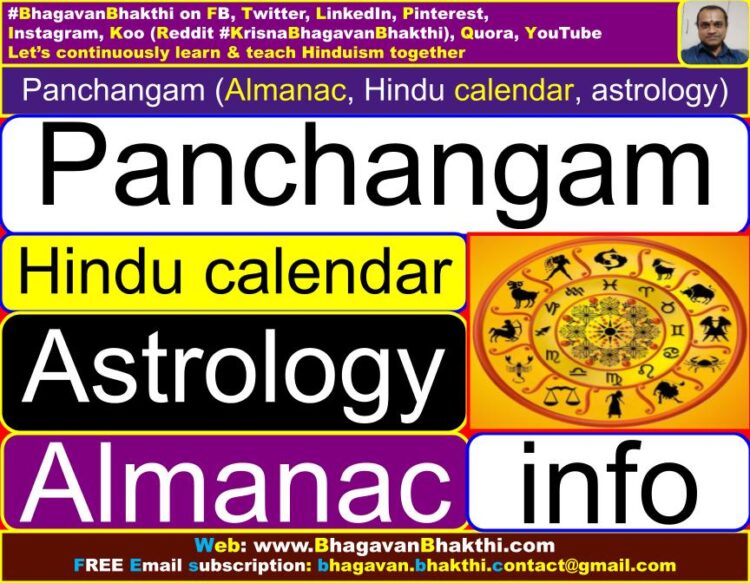
A Panchāngam, in Sanskrit is pronounced as पञ्चाङ्गम् (or simply पंचांगम् / Pan̄cāṅgaṁ) is a Hindu Sanatana Dharma divine Hindu calendar and an almanac.
What is panchang very short answer : The Hindu Panchāngam follows the established units of Hindu timeframe, and presents unique tithis (dates) and their calculations in correct mathematical way.
Panchangam meaning in English : In India, a Panchāngam is pronounced in different ways like in Hindi it is called as Panchang, in Kannada it is called as Panchanga, in Telugu is called as Panchangamu, etc. Panchangams are mainly used in Jyotisha Shastra (Astrology).
Panchangam timings varies through out India because of the time variations as per the different states in India.
This is because in Assam the Sunrise time may be different and in Gujarat Sunrise timings may be different. Similarly in all parts of India. But this time difference is in few minutes.
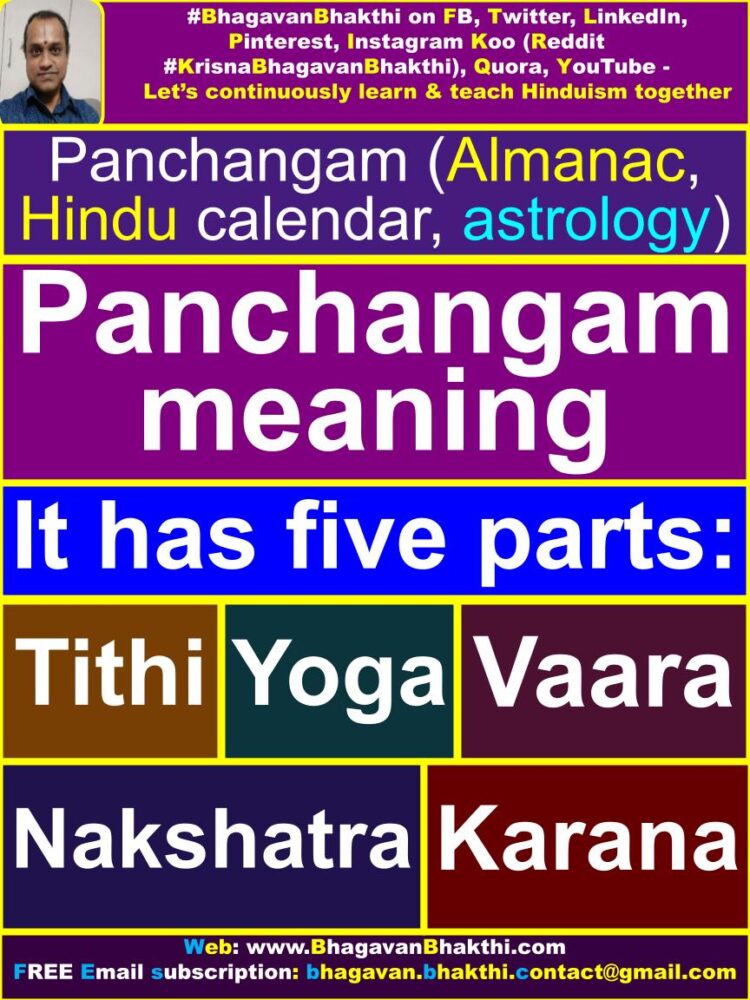
First of all let us all understand the meaning of the word ‘panchangam’:
Panchangam – Pancha = five, angam = parts.
What are the 5 things in Panchang? : Panchangam, as the word suggests comprises five important aspects and they are as given below:
1. Tithi | 2. Vaara (day) | 3. Nakshatra (star) | 4. Yoga and | 5. Karana |
All the above five change every day, every month, every fortnight and also every season. Here the day name does not change, but today’s tithi (day) and vaara are not the same tomorrow. It is the same case with nakshatra, yoga and karana also.
The grantha / Hindu divine book which gives details about these five aspects is called ‘panchangam’. But when we open the page of a panchangam, we get totally confused.
These five aspects are represented by symbols and we find it difficult to understand them every time we open a panchangam.
A panchangam gives us details such as the varsha / year, ritus / seasons, masams / months, day of planets, details of preparing horoscopes, aspects of planets, favorable and unfavorable time (Visha ghaliga / inauspicious time and Amrita ghaliga / auspicious time) and other auspicious time for celebrations.
Panchangam also gives details about the five aspects mentioned earlier. The five aspects are indicated by the first letters of words relating to them.
Before we try to understand panchangam, let us try to know some basic things about Tithi, Vaara, Nakshatra, Yoga and Karana.

Information about Tithi is as given here : One single masam / month has two fortnights namely:
1. The brighter half (Shukla paksha) (Waxing moon) and | 2. The darker half of the moon (Krishna paksha) (Waning moon).
From the ‘purnima’ (full moon day) when Chandra / Moon shines in all glory, appears to grow smaller. Chandra / Moon goes on losing one aspect (of the sixteen) each day and totally disappears on the ‘amavasya’ (new moon day).
Krishna Paksha : In this way from the ‘purnima’ (full moon day) Chandra / Moon goes on losing one brighter aspect each day and that phase of the Chandra / Moon is called Krishna paksha.
Shukla Paksha : From this point, Chandra / Moon begins to grow brighter and bigger and we see him in all his glory on the ‘purnima’ (full moon day) and these fifteen days from the Shukla paksha.
We have fifteen tithis (days) on these two parts. And over all there are 30 tithis (days). In fact, there are sixteen tithis in a month. The fourteen in each half go on changing.
The first, second, third and fourth tithis are named Padya, Dvitiya, Tritiya and Chauti etc.
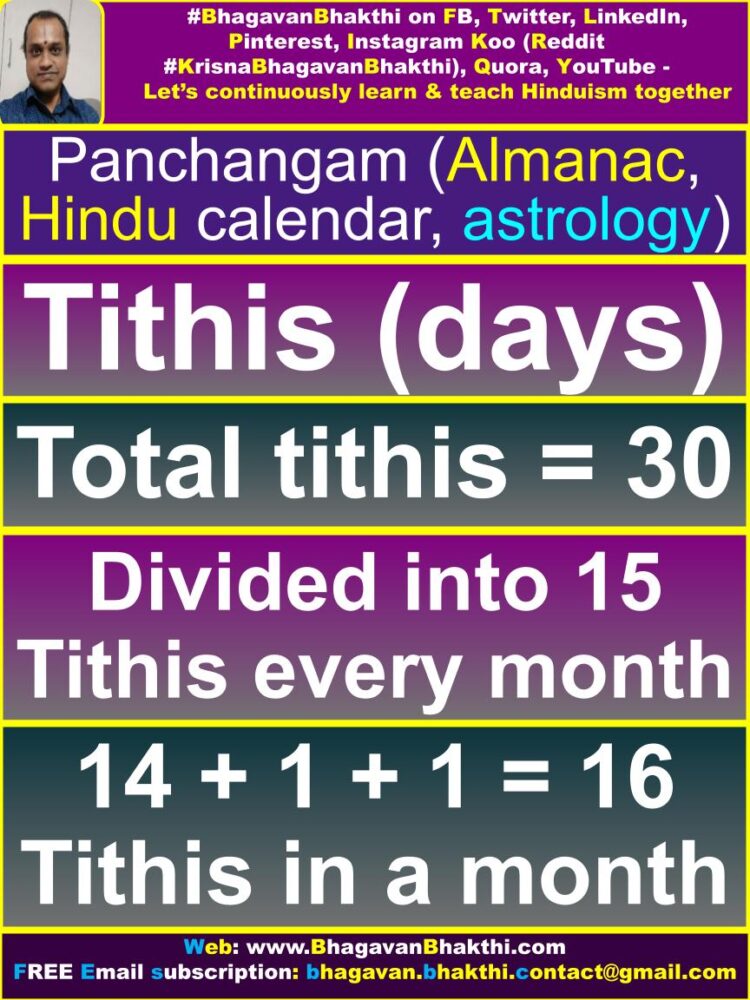
A day comprises sixty ghaliga (one ghaliga / time period is equal to 24 minutes). At this point, we have to remember that all thithis (days) are not as long as sixty ghaliga (time period). Some are shorter and some are longer.
When two tithis (days) which are shorter than sixty ghaliga come one after the other, one of the two is marked as ‘upari’ meaning besides. This means six tithis will be over in five.
This happens when the tithi absent at sun-rise and that tithi is considered ‘upari’.
On the other hand when two tithis longer than 60 ghaligas appear one after the other, sometimes one tithi is considered to be present on two days.
As a result of this, sometimes, we come across two padya or ekadashi appearing on two days continuously.
The reigning tithi at sun rise should be taken as the tithi of the day. (only in the case of pitrukaryas such as Shraaddha, the prevalent tithi is taken into account).
The reigning length of the time of tithi is clearly mentioned in the panchangam. For example, an entry such as Dashami 3.15 means that the tithi Dashami lasts three ghaliga and 15 Vighaliga from the sun-rise. (One ghaliga is equal to be vighaliga).
If the sun rise is at 6.00 a.m., Dashami tithi lasts till about 7.30 a.m. Then Ekadashi is going to be the tithi for the day, but for all practical purposes we have to take Dashami the tithi for the whole day. Every tithi has its own reigning deity.
Astrologers recommend appearing rituals performed in the name of the reigning deity of the tithi in case there are problems relating to that tithi.
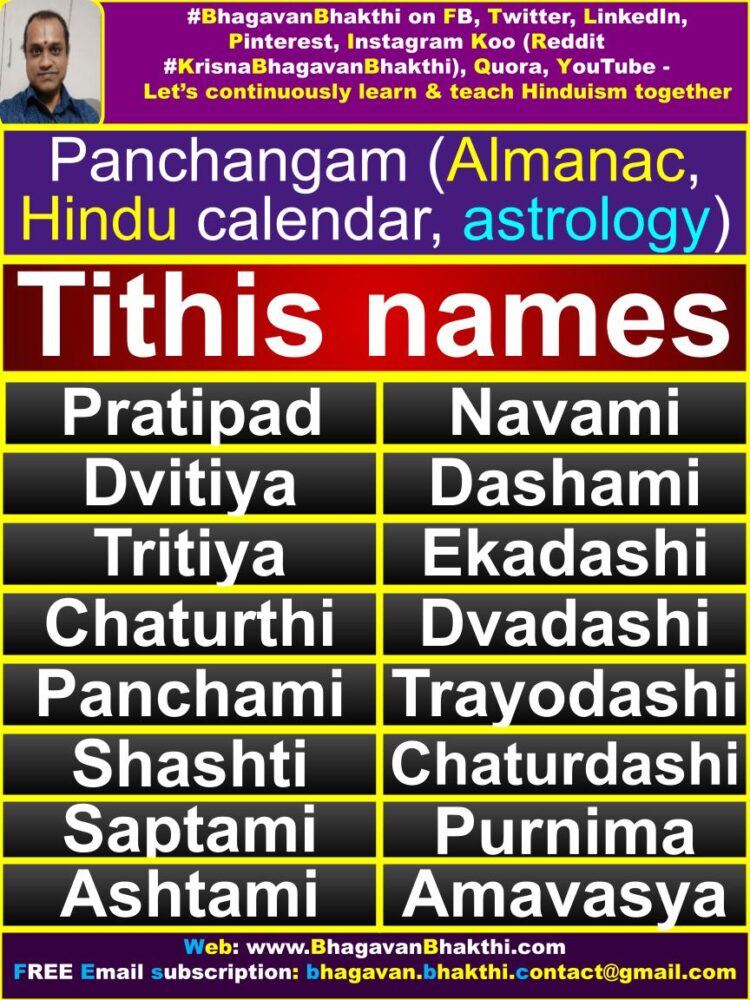
A table is given below to clearly understanding information about tithis:
S. N. | Symbol | Tithi (Day) | Reigning deity | Doing Sankalpa
1. Pra (One) – Prathama (Pratipad) | Padya | Lord Sri Yajneshwara | Pratipadi (Prathamayam)
2. Dvi (Two) | Dvitiya | Lord Sri Twashtr | Dvitiyayam
3. Tri (Three) | Tritiya (Trutiya) | Goddess Sri Parvati Devi | Tritiyayam
4. Cha (Four) | Chaturthi (Chouti) | Lord Sri Ganapati | Chaturtyam
5. Pan (Five) | Panchami | Sarpa (Serpent) | Panchamyam
6. Sha (Six) | Shashti | Lord Sri Skanda | Shashtyam
7. Sap (Seven) | Saptami | Lord Sri Surya Deva | Saptamyam
8. Ash (Eight) | Ashtami | Eshwara (Lord Shiva) | Ashtamyam
9. Nav (Nine) | Navami | Ashtavasya | Navamyam
10. Dash (Ten) | Dashami | Iravata | Dashamyam
11. Ekad (Eleven) | Ekadashi (Haridina) | Dharma (Lord Sri Yama Deva) | Ekadashyam
12. Dvad (Twelve) | Dvadashi | Lord Sri Vishnu | Dvadashyam
13. Trad (Thirteen) | Trayodashi | Manmatha (Lord Sri Kama Deva) | Trayodashyam
14. Chad (Fourteen) | Chaturdashi | Kalipurusha | Chaturdashyam
15. Pur (Full moon day) | Purnima | Lord Sri Chandra (Moon) | Purnimayam (Pournamyam)
16. Ama (New moon day) | Amavasya | Pitrudevas (protectors of ancestors) | Amavasyayam
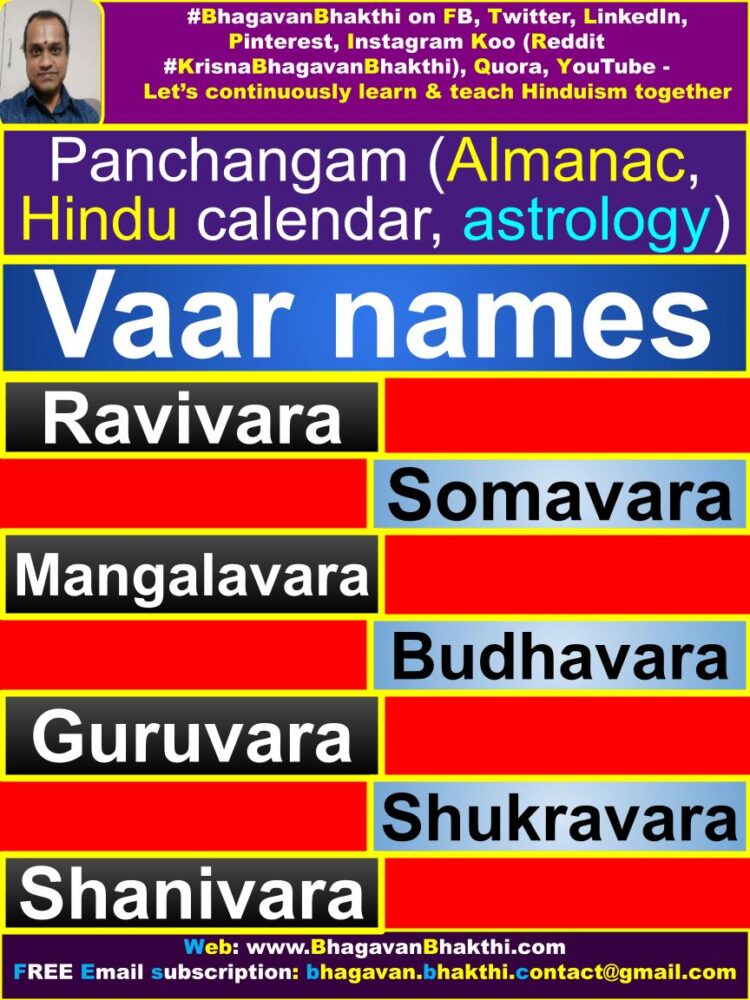
About Vaara (Vaar) (var) : A group or cluster of seven days is called ‘vaara’ (vaar) (a week).
In reality the Gregorian week is not synonymous with our concept of vaara (vaar). Both are individual days named after seven grahas (planets) excluding Rahu and Ketu. Days change at Suryodaya / Sunrise.
In the Panchanga they are indicated by the first letters of their names as give below:
Symbol | Days | Alternate Name | Abhimani Devata / Reigning Diety
Ra | Ravivara (Ravivar) | Bhanuvasara / Adityavasara | Shiva
Cha | Chandravara (Somavar) | Somavasara / Induvasara Durga
Ku | Kujavara (Mangalvar) | Mangalavasara / Boumyavasara | Shanmukha (Kartikeya)
Bu | Budhavara (Budhvar) | Soumyavasara | Vishnu
Gu | Guruvara (Guruvar) | Brihaspativasara | Brahma
Shu | Shukravara (Shukravar) | Bhargavavasara | Indra
Sha | Shanivara (Shinivar) | Mandavasara / Sthiravasara | Yoga
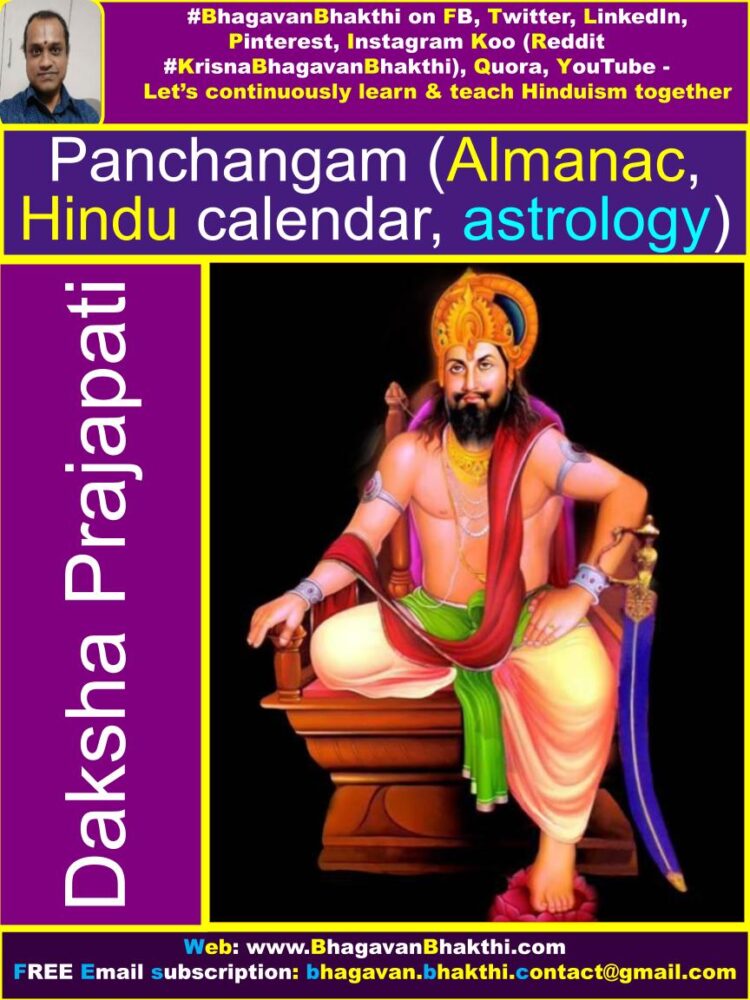
About Nakshatra : Daksha Prajapati had sixty daughters. In that, twenty seven of them were married of to Lord Sri Chandra Deva.
It is an interesting thing that all those twenty seven names are not in feminine gender. Shravana and Moola are in the neuter gender, and while Pushya and Hasta are in the masculine gender.
Therefore referring to them as Hasta Nakshatre, or Moola Nakshatre, the use of the long vowel at the end of the name is not acceptable.
Thus we need to use the short vowel at the end of the name – Moola nakshatre or Hasta nakshatre is preferred.
Chandra / Moon in his revolutionary course, travels from one nakshatra to the other every day.
Chandra / Moon will be there in one nakshatra for the whole day. That nakshatra is called the ‘nitya nakshatra’ (everyday’s star).
Surya / Sun will stay in one nakshatra for about 13 days. That nakshatra is called the ‘nakshatra’.
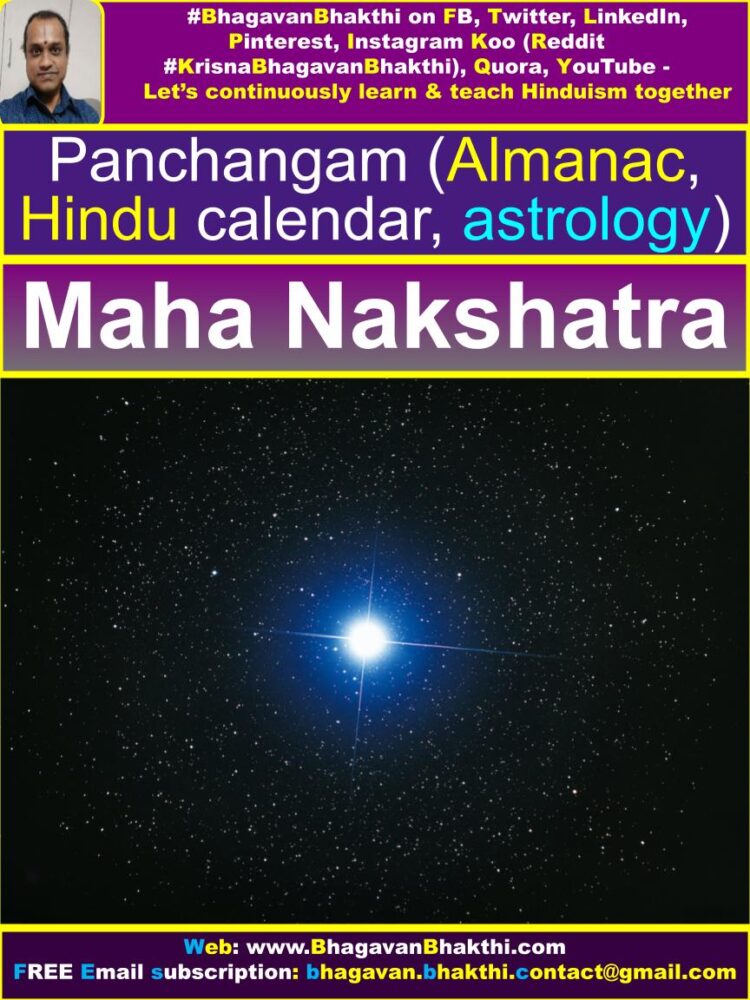
There is a reference to the ‘Mahanakshatra’ in the panchangams, which follow ‘soura’ / Sun system and have been published.
In each and every panchangam, the days are indicated by their first letter. They are printed after tithi and vaara (vaar) this entry is followed by the length of its being present in terms of ghaligas.
This indicates the length of the reign of that nakshatra after Suryodaya / sun-rise on a given day.
For example – ‘Ashvi-15′ means, ‘Ashvini Nakshatra’ is there for 15 ghaligas (six hours) from sunrise.
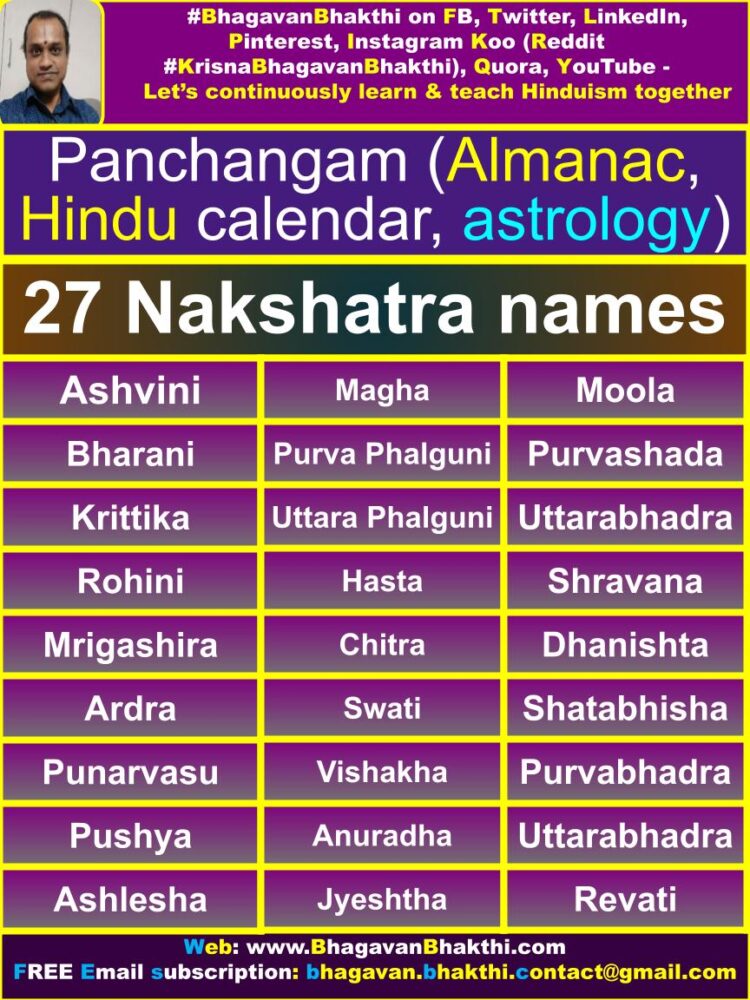
The below given table indicates nakshatra, rashi and their abhimani Devata / reigning deities:
Sl.No | Symbol | Nakshatra | Related Rashi | Abhimani Devata / Reigning Deity
1. As | Ashvini | Mesha | Ashvini
2. Bha | Bharani | Mesha | Yama
3. Kri | Krittika | Mesha/Vrishabha | Agni
4. Ro | Rohini | Vrishabha | Brahma
5. Mri | Mrigashira | Vrishabha/Mithuna | Chandra
6. Ar | Ardra | Mithuna | Rudra
7. Pu | Punarvasu | Mithuna / Karkataka | Aditi
8. Pus | Pushya | Karkataka | Brihaspati
9. Asl | Ashlesha | Karkataka | Sarpa
10. Ma | Magha | Simha | Pitru
11. Poo | Purva Phalguni | Simha | Surya
12. Utta | Uttara Phalguni | Simha / Kanya | Aryama
13. Ha | Hasta | Kanya | Savitri
14. Chi | Chitra | Kanya / Tula | Tvashtra
15. Sva | Swati | Tula | Vasu
16. Vi | Vishakha | Tula / Vrischika | Indrani
17. Anu | Anuradha | Vrischika | Mitra
18. Jye | Jyeshtha | Vrischika | Chandra
19. Moo | Moola | Dhanu | Nrithi
20. Poo | Purvashada | Dhanu | Aapah
21. U.sha | Uttarabhadra | Dhanu / Makara | Vishvedeva
22. Shra | Shravana | Makara | Vishnu
23. Dha | Dhanishta | Makara / Kumbha | Ashtavasu
24. Sha | Shatabhisha | Kumbha | Varuna
25. Puba | Purvabhadra | Kumbha / Meena | Brahma / Ajaikapat
26. Ubha | Uttarabhadra | Meena | Brahma
27. Re | Revati | Meena | Pooshan

About Yoga : Multiple dictionaries have given over twenty five meanings to the word ‘yoga’.
In panchangam, it is used as a common uses and refer to twenty seven ‘yogas’ (not Yogasana Yoga) starting from Vishkambha yoga. As in the case of nakshatras, yoga also lasts for sixty ghaligas. It changes every day.
The name of the yoga is indicated by the letter as its symbol followed by its length indicated in ghaligas from sun rise.
An entry Vari – 10 means the yoga variyan reigns for 10 ghaligas from Suryodaya / Sun rise during that day.
Smriti literature has identified reigning deities for each yoga. There are 27 yogas. Among them Vyateepata and Vaidriti yogas have assumed great importance.
In Krishnacharya Yoga, it is mentioned that on days when these yogas appear are have to eat only ones and have to follow certain vratas.(Shraaddha, feeding brahmanas etc.).
“vyateepato mahayogah sarvakaryeshu siddhidah | dritistu dhairyadanityam … ||
It is considered to be an auspicious time, thus some panchangams have printed in bold letters.
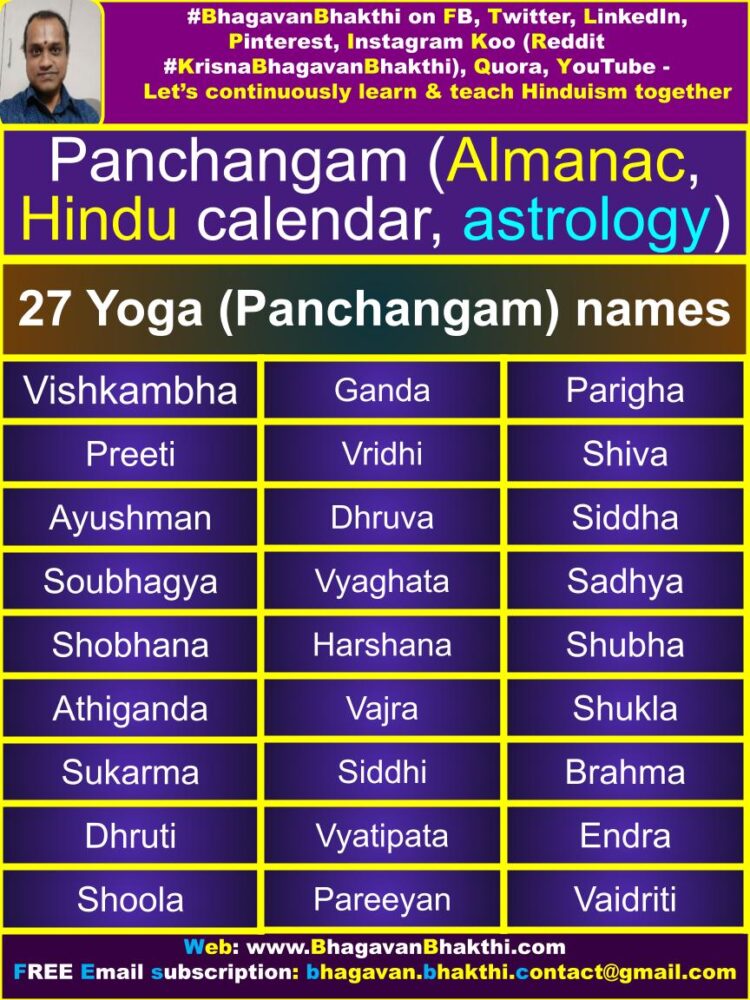
The below table gives us the details about yogas:
Sl. No. | Symbol | Yoga | Abhimani Devata / Reigning Deity
1. Vki | Vishkambha | Vishvedeva
2. Pree | Preeti | Marut
3. Aye | Ayushmaan | Hiranyagarbha
4. Sau | Soubhagya | Durga
5. Sho | Shobhana | Prithvi
6. Ath | Athiganda | Aditi
7. Dhr | Sukarma | Surya
8. Shoo | Dhruti | Ratri
9. Gan | Shoola | Indra
10. Gan | Ganda | Marut
11. Vri | Vridhi | Ratri
12. Dhru | Dhruva | Agni
13. Vya | Vyaghata | Hari
14. Har | Harshana | Indra
15. Va | Vajra | Hiranyagarbha
16. Si | Siddhi | Vayu
17. Vya | Vyateepaata | Agni
18. Paree | Pareeyan | Hari
19. Pari | Parigha | Indra
20. Shi | Shiva | Indra
21. Sdhi | Siddha | Hiranyagarbha
22. Sa | Sadhya | Vayu
23. Shu | Shubha | Pavamana | Soma
24. Shu | Shukla | Prithvi
25. Bra | Brahma | Indra
26. Em | Endra | Vishvadeva
27. Vai | Vaidriti | Marut
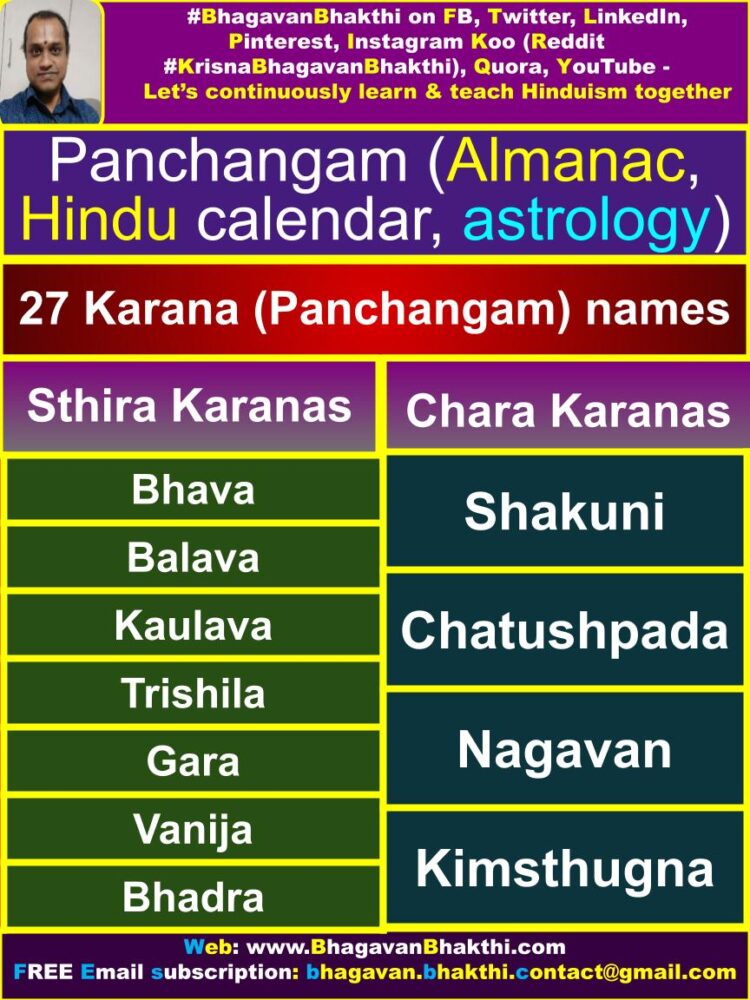
About Karana : Karanas, are eleven in number. The first seven of them are considered ‘shthira Karanas’ (fixed Karanas), the last four are considered ‘chara Karanas’ (mobile Karanas) in astrology. A tithi has two Karanas that rule a day.
Chara karanas begin on the second half the brighter side of the Chandra / Moon (Shukla paksha) and continue to rule till the fourteenth day of the darker of the Chandra / Moon (Krishna paksha) and recur regularly.
The four Shukla Karanas on the second part of Krishna chaturdashi and continue to rule till the second part of Shukla padyami. They appear once a month.
Sthira Karanas | Chara Karanas
Bhava | Shakuni
Balava | Chatushpada
Kaulava | Nagavan
Trishila | Kimsthugna
Gara |
Vanija |
Bhadra |
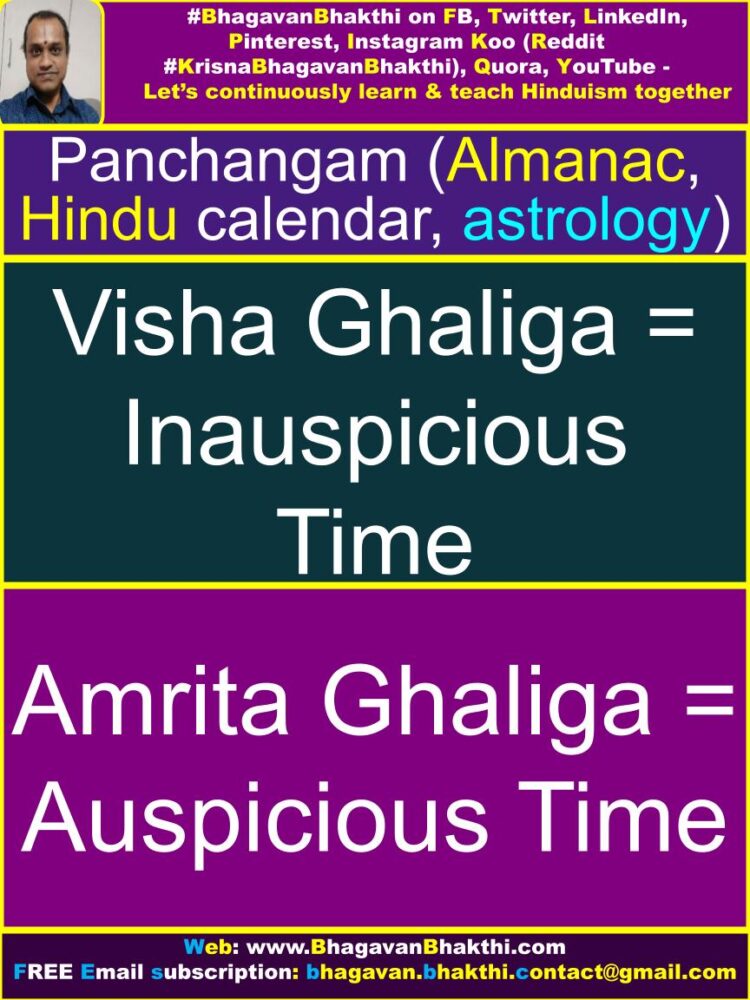
About Visha and Amrita ghaliga (auspicious and inauspicious time) : There is a reference to Visha and Amruta (amrita) besides the five aspects in every panchangam.
When we fail in our endeavours, we grumble for having begun the work in an inauspicious time.
Visha ghaliga (here visha means poison, that is, inauspicious time) is not auspicious to begin any work. It is always advisable to begin a work in Amrita ghaliga (auspicious time). Here ‘Vi’ of ‘Visha’ Visha / poison and ‘Aa’ means ‘Amrita’.
Four ghaligas (96 mins) after the time entered against ‘Vi’ or ‘Aa’ will have Visha or Amrita ghaliga. (Please note that, it is not up to the time entered that we have either Visha or amrita ghaligas).
When a Nakshatra / star runs for the entire period of 60 ghaligas, Visha and Amrita will be there for four ghaligas respectively.
When the duration of the nakshatra / star is less than 60 ghaligas, duration of Visha and Amrita varies. That means four ghaligas after the time specified, the influence of Visha and Amrita will be present.
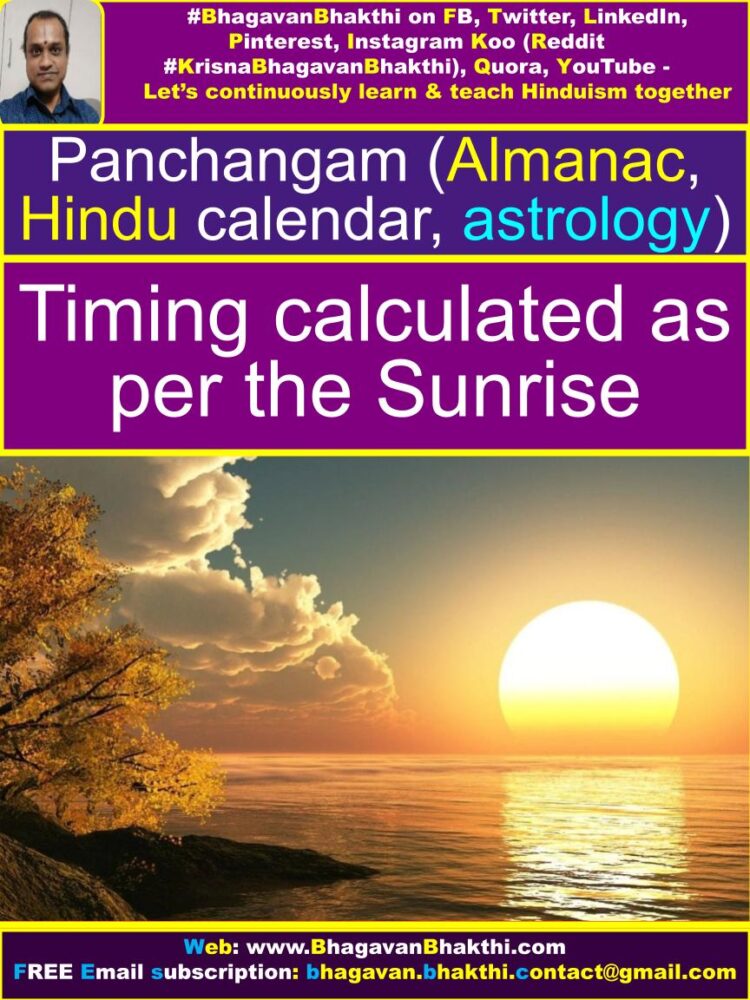
For example the entries vi 32-31 and Am 40-15 means that, Visha sets in after 32 ghaligas and lasts for four ghaligas (from 6.00 to 7.30 p.m.) and Amrutha sets in 43 ghaligas after Suryodaya / sun-rise and lasts for four ghaligas (10.00 to 11.30 p.m.).
When either Visha or Amrita is set in the last part of the night, their effects will be carried forward and three ghaligas after Suryodaya / sun rise the two will have their affect.
After the entry of Visha and Amrita, we see an entry which highlights the special features of the day if any:- For example Krishnajanmastami, Ramanavami and so on.
Then we find the change in the movements of grahas. E.g., Anu 3, ku 18 after sun rise 18 ghaligas later kuja (Mars) enters the third part of Anuradha nakshatra.
In the same way Vrishabha Budhah, Haste Arkah. In same entries we come across Uttama Manvaadi (Manvatara and others), Koorma Kalpaadi (Koorma Kalpa and others), Tretayugaadi (Tretayuga and others) and other details.
It may be understood as, there are fourteen Manvantaras in a Kalpa. In the present Shvetha Varaha Kalpa, six Manvantaras beginning with Svayambhu have been over and now it is Vaivasvata Manvantara.
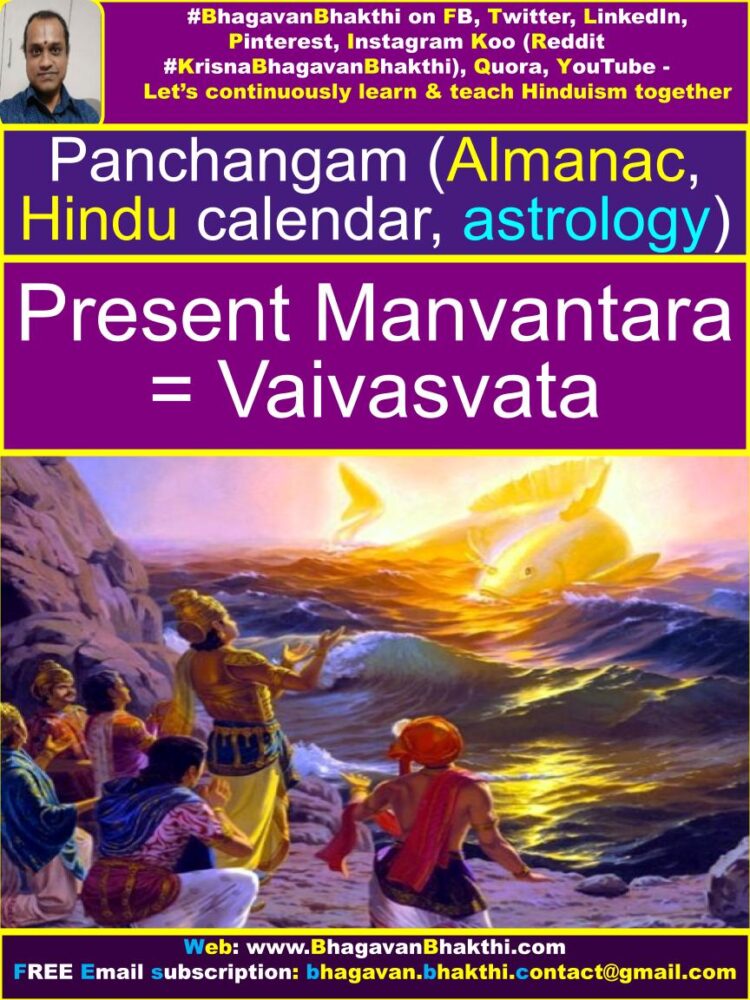
The day each Manvantara began, is indicated by the names of the ruling Manvantara with an additional word Manvaadi (Manvantara and others).
For example, the first day of Uttama Manvantara is referred to as Uttama manvaadi (manvantara and others). In the same way, we have Svayambhuva Manvaadi (Manvantara and others) etc.
The Creator, Sri Chatur Brahma Deva’s one day time is considered one Kalpa. Thousands of such Kalpas have been completed since the creation of this multiverses.
Now the present Sri Chatur Mukha Brahma Deva has completed fifty years (fifty first running) of his total hundred years (as per the Satya loka).
Sri Chatur Mukha Brahma Deva is in its fifty first year. It is the twenty sixth day of the first month of his fifty first year. This day is called Shveta Varaha Kalpa.
This Kalpa began on ‘Chandra Yugadi’ (Ugadi). Panchangams highlight the beginning of other famous Kalpas such as Koorma Kalpaadi (Kalpa and others) and so on.
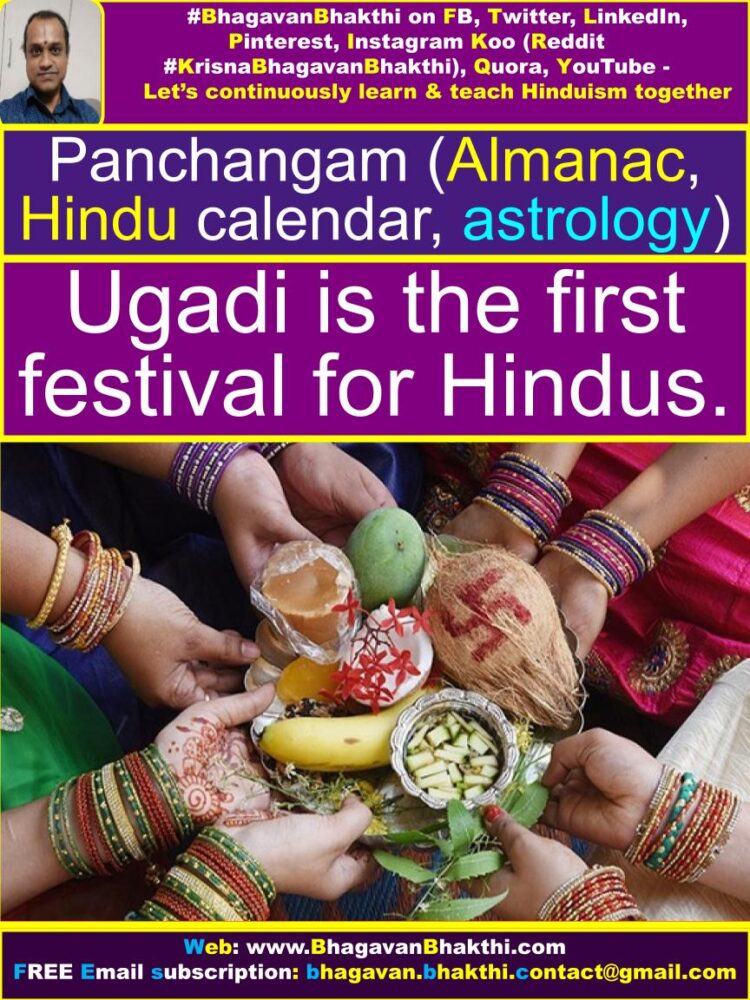
There are twenty one sequence of Chaturyugas (or Mahayuga) (four yugas – Satya Yuga, Treta Yuga, Dvapara Yuga and Kali Yuga).
In the present Vaivasvata Manvantara, 27 Chaturyugas have completed and the last Kali Yuga of the 28th ‘Chaturyuga’ (Mahayuga) Cycle is going on.
(One Chaturyuga or Mahayuga has four Yugas in it, that is, Satya (Krita) Yuga, Treta Yuga, Dwapara Yuga and Kali Yuga.)
Panchangams refer the beginning of Treta and Dvapara Yugas. Panchangams have many such details. Basically the details given above would be enough to have clear understanding of the panchangam.
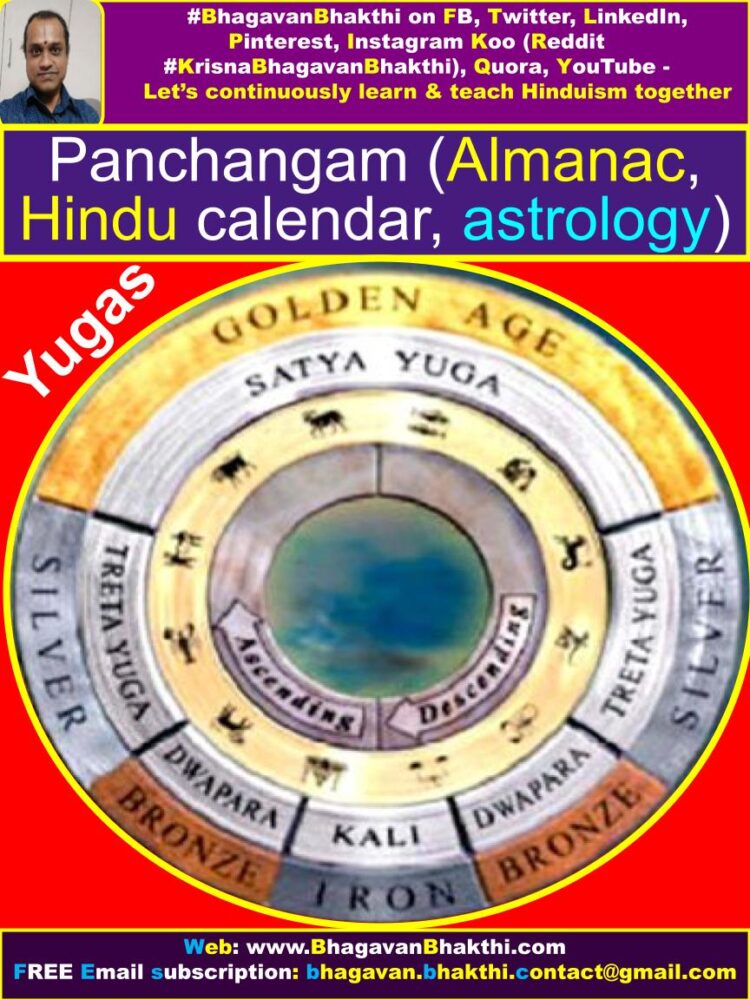
More information will be added to this on regular basis. Please visit this post (article) after some time to get updated information.
Continue reading about Hinduism (Sanatana Dharma) :
Lord Sri Srinivasa (Balaji full information)
Ramayana information, facts, significance, importance, etc.
Maharishi information, facts, importance, significance, etc.
Rivers information in Hinduism (Sanatana Dharma)
Hinduism (Sanatana Dharma) information, facts, etc.
Mahabharata information, facts, significance, importance etc.
To watch videos on #Hinduism #Sanskrit language, SUBSCRIBE to my YouTube channel from this below link:
#BhagavanBhakthi YouTube channel
Dear friends, if you need any clarifications about this post, kindly let me know, I will definitely try to answer all of them.
Also your one LIKE, one COMMENT, One Share, one SUBSCRIPTION is highly important.
This will help to know the quality of this content and also it will be helpful to know if any improvements is required for the content.
If you feel this content is useful to you and has helped you to improve your knowledge, kindly share this with your well-wishers.
Because “SHARING MEANS CARING”.
To receive FREE EMAIL SUBSCRIPTION about #BhagavanBhakthi, you can send an email to bhagavan.bhakthi.contact@gmail.com from your email ID.
NAMASTE!
SRI GURUBHYO NAMAHA
OM NAMO NARAYANAYA
Sri Krishnaarpanamastu